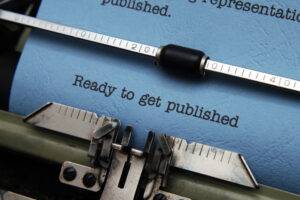Written by Alex Dorian

What is a writing sample? A writing sample is any piece of writing work that professional writers submit to editors or prospective employers to showcase their ability to write within a specific domain. It could be a chapter of a book, marketing copy, an article written for a website or blog– or even a piece of technical writing as the situation warrants. Samples might be provided as a single piece of representative work or as part of a broader portfolio that showcases a diversity of writing skills.
The type of writing sample you submit, and the way you format it, depends
entirely on the type of publisher you’re submitting it to and the audience or readership you’ll be writing for. The editor of a publishing house would look for something different than that of a major newspaper, and a marketing content manager will have very different expectations than a technical writing team lead.
What your writing sample actually is depends on your specialty, whether that’s citizen journalism or marketing copy or non-fiction shorts. That specialty will also determine the relationships you’ll have to build to get published or earn a full-time position.
But whether you’re applying for a job as a general assignment reporter at The Boston Globe or looking to secure a freelance writing contract with a marketing agency, you can be sure you’ll be expected to present a few pieces you’ve written along with your initial application.
Here we’ll take a look at the primary types of writing samples writers are most curious about – fiction and non-fiction book authorship, journalism, content marketing, and freelance copywriting. We’ll walk you through the best way to format samples for each, and the professional submission protocols that that will stack the odds in your favor.
Submitting a Sample of Your Fiction or Non-Fiction Work to an Agent Who Can Represent You
Whether you’re a novelist or a nonfiction book writer, unless you plan to just publish independently, getting signed with an agent is a standard first step to getting your work out into the world. Don’t expect Penguin Random House to just accept your writing sample if you’re not represented. Fact is, the big publishing houses won’t even look at submissions unless they come from an agency.
In the world of book authoring, it’s wise to start by getting signed with an agent who can put your work in front of the right publishers.
But once an agent agrees to represent you, they’ll identify publishers that would be a good fit for what you have to offer. They’ll be vested in your success and will make an earnest effort at pitching your work to the right publishers.
 Agents themselves can specialize in particular genres, maintaining a network of connections with publishers that are well established in those areas. So, it’s wise to start by identifying literary agents interested in the kind of work you do. This can give you a better shot of getting some traction in your niche, whether that’s historical nonfiction, political analysis, or sci-fi and horror. Services like the Poets & Writers Literary Agent Database and Publishers Marketplace can help you research and find agents that would be a good fit.
Agents themselves can specialize in particular genres, maintaining a network of connections with publishers that are well established in those areas. So, it’s wise to start by identifying literary agents interested in the kind of work you do. This can give you a better shot of getting some traction in your niche, whether that’s historical nonfiction, political analysis, or sci-fi and horror. Services like the Poets & Writers Literary Agent Database and Publishers Marketplace can help you research and find agents that would be a good fit.
Of course, your manuscript should be in top shape when you present it to a prospective agent. Many agents will only request the first two chapters or so, and others may only want the first 10 pages. This gives you a chance to give one final final pass through the pages you know for sure they’ll be reading.
Securing an agent typically starts with a query letter before even submitting your sample. This is where you’ll have a chance to introduce yourself and pitch your book. There are a few rules of thumb you should follow when developing your query letter:
- It should be no longer than one page: Somewhere between 200 and 450 words.
- Hit the important points: This includes the fiction genre or category of nonfiction work, the word count, and the title.
- Describe what your book is about: Give the elevator pitch. Entice the agent. Capture their imagination. Run it by your writer’s circle and ask them: would they want to read the work based on the description alone? If you’re not already a part of a writing circle, join one. Reach out to colleagues from your alma mater or join an online community such as Critique Circle or Scribophile.
- Be bold but humble: Agents are some of the most overworked people you’ll ever meet and asking them to take the time to consider your work is common courtesy.
Only send in the writing sample if the agent requests it. If you don’t hear anything within a month of your first query, reach out a second time. If you hear nothing back from then, assume they’ve rejected you. Take it for what it is and move on. Part of being a writer is learning to accept rejection, bouncing back from it quickly, and learning what you can from the process.
Creating something people want to read takes vulnerability. Getting your work in front of readers takes resilience.
How Your Agent Presents Your Writing Sample to a Publisher
 Once you find an agent, they’ll work with you to further polish your writing sample before submitting it to publishers. Your agent will be the one handling the query letters from there, reaching out to publishers, and negotiating everything from the terms of your book’s release to the royalties you’ll receive if it sells.
Once you find an agent, they’ll work with you to further polish your writing sample before submitting it to publishers. Your agent will be the one handling the query letters from there, reaching out to publishers, and negotiating everything from the terms of your book’s release to the royalties you’ll receive if it sells.
Make sure the sample piece stands on its own. This can be tricky if your most enticing piece of the work isn’t in chapter one where you’ve begun establishing the story and characters. You’ll inevitably need to workshop with your agent and those in your writer’s circle who are familiar with the whole manuscript to help you add in the contextual pieces you’ll need to set the stage for the sample you submit.
Most publishers look for samples that are between 8,000 and 12,000 words long, so expect to submit anywhere between 16,000 and 24,000 words of copy including the contextual material. That doesn’t give you any room for dross. Every word needs to pop.
Some Caveats for Textbook Writing Samples
Publishers of nonfiction work considering textbook proposals will look for sample chapters that represent the crux of what you’re writing about. That may not be the introduction and first chapter.
In the world of non-fiction, particular textbook writing, there isn’t usually an expectation that you have a complete manuscript. It’s not uncommon for publishers to sign non-fiction authors on the merit of their expertise and credentials in a given field and on the basis of the samples they submit, and then pay an advance toward the finished work.
Submitting a Writing Sample to a Newspaper
 Journalism can be a very competitive field. No matter how great a writer you might be, it can take years to earn your stripes and build a reputation as a serious journalist. A single story can mean developing multiple sources and meeting several times with each one, keeping your ear to the ground to understand intersecting issues, and then rigorously checking every fact embedded in your work. And that’s before you even pull it all together into a coherent piece of work.
Journalism can be a very competitive field. No matter how great a writer you might be, it can take years to earn your stripes and build a reputation as a serious journalist. A single story can mean developing multiple sources and meeting several times with each one, keeping your ear to the ground to understand intersecting issues, and then rigorously checking every fact embedded in your work. And that’s before you even pull it all together into a coherent piece of work.
Before Creating “The Wire,” David Simon Walked the Walk Out in the Real World
Becoming an excellent journalist demands years of immersive reporting on whatever slice of the world you’re compelled to investigate.
 When David Simon, the showrunner for HBO’s “The Wire,” got an entry level position with The Baltimore Sun, he was immediately assigned to the police beat. In an interview with Eric Deggans at Columbia Journalism Review, Simon explained that he never intended to shy away from doing whatever it took to get first-hand accounts from the people who could tell him the whole story.
When David Simon, the showrunner for HBO’s “The Wire,” got an entry level position with The Baltimore Sun, he was immediately assigned to the police beat. In an interview with Eric Deggans at Columbia Journalism Review, Simon explained that he never intended to shy away from doing whatever it took to get first-hand accounts from the people who could tell him the whole story.
“If I wanted to hear anything from anyone other than the police, I had to be able to walk into a rowhouse and convince people very quickly that I’m not a cop and I really want to hear what you have to tell me about what happened last night,” Simon told Deggans. “And there were reporters who did not want to open that door.”
Here’s the lesson: A good news article isn’t just about adhering to stringent formatting rules. More than anything, it’s about learning from your sources, and presenting their perspective in a genuine light.
Your commitment to developing engaging, factual stories should shine through in the article you submit to a newspaper. Assuming you’re applying for a full-time staff position or a freelance position as a contributing writer, the editor fielding applications will ask for a couple published examples of the work you’ve done.
What if you don’t have any published work? Plenty of journalists get their start through internships that put them in a position to showcase their talents and grease the skids for a seamless college-to-career transition into journalism. But if that was the case for you, it’s not likely you’d be reading an article about submitting samples. More than likely, this is your first foray into journalism, in which case you have no choice but to start small.
Even local daily papers in your area may not provide much of an inroad to getting your first byline. Often, it’s the grassroots weekly circulars and independent publications with little to lose where you’ll find editors who have the freedom to take a chance and give up-and-coming journalists their first breaks.
Sure, not all publication credits are created equal, but in the end it’s the merit of what you have published that counts. Even editors at mainstream papers know that new talent needs to start at ground level, so if it’s a powerful piece, it could end up being seen by the right people and lead to bigger breaks. There’s irony in the fact that the free local music rag in many major metros have a bigger and more consistent audiences than established papers, even if they only have the budgets to pay a few popular columnists. In the end, you might find that’s the best fit for what you do anyway.
How to Format a Sample Article for a Newspaper
It’s helpful to think of article formatting with a particular story in mind. Suppose you covered a proposal for a 200-unit apartment building in your local city. How would you present the information you gathered about the project? Your piece should contain the following components:
Title
Think of the title as an opener for a conversation. In our example, your title would read something like “Developer Proposes 200-Unit Apartment Building on Danvers Street.” You’re not giving too much away, but you’re disclosing what the article is about.
Lead Sentence
The lead sentence is where you’ll pull the reader in by providing the where, when, who, and what. Your lead sentence about the apartment complex could read like this: “Triton Development submitted a proposal to the Springfield Zoning Board for a 200-unit residential building at 314 Danvers St last Tuesday.” Here, you get the who (Triton Development), when (last Tuesday), what (a 200-unit residential building), and where (314 Danvers St.).
Introduction
The introduction is where you expand on the information within your lead sentence. What other features are included in the development project? Will the developers construct a parking garage to accommodate tenants? What will the apartment building replace at 314 Danvers St.?
Opening Quotation
What do the people involved with the story have to say about it? In your case, you may want to quote the project lead with Triton Development, or a member of the Springfield Zoning Board. The quote should build on the introduction and lead into the heart of your story.
Main Body
This is where you disclose the details of your story. You provide all the pertinent information from different perspectives. How are residents reacting to the proposal? Were there any concerns from the Zoning Board? What’s the next stage of the process?
Closing Quotation
Capture the essence of this story as told by someone involved in the project. What will be the development’s impact if approved? What is the next major hurdle for the developer? Think of using a quote that will help the reader keep the story in the back of their minds.
Once you’ve nailed these features, review your article to ensure that it adheres to a style guide. Of course, the Associated Press (AP) Style Guide is the go-to for universally recognized copy standards around presentation and formatting. You need to subscribe to access the Style Guide, but at less than $30 a year, it’s a small price to pay for a serious reference guide you’ll use daily.
Submitting a Writing Sample to a Content Marketing Team
 Whatever marketing effort you’re lending your writing skills to, it certainly helps to know as much about the niche or the specific product as possible. And, of course, some niches are going to be a lot easier than others to get familiar with. As a rule, the more specialized and technical the niche or product is, the more challenging it is for companies to find writers.
Whatever marketing effort you’re lending your writing skills to, it certainly helps to know as much about the niche or the specific product as possible. And, of course, some niches are going to be a lot easier than others to get familiar with. As a rule, the more specialized and technical the niche or product is, the more challenging it is for companies to find writers.
It’s a good idea to have a general specialization in product niches that people frequently shop for online. Online shopping these days can be a lengthy process of information gathering and side-by-side comparisons that consumers work through long before being ready to make a buying decision. Marketers are keenly aware of this and tailor their content accordingly. Whether it’s consumer electronics, the automotive industry, insurance or financial products, being able to write competently in a field that requires a solid grounding in subject matter knowledge will increase the value of your work.
Still, few marketing writers become true subject-matter experts in any one field on the same level as technicians and engineers, and few are expected to. That’s a distinction reserved for technical and academic writers. But that doesn’t mean you can’t set yourself apart from other writers by specializing. It can take a considerable amount of time to get there, but it could pay off in the end.
Generally, there are three rules of thumb you should follow when submitting a writing sample to land a position on a content marketing team, whether as a staff writer or freelance contributor.
Keep your audience in mind
Who’s reading your articles? IT managers? Sales executives? Soccer moms? Whom you’re writing for dictates the type of language you use. Is your audience analytical? Do they have advanced degrees? Are they more carefree and laid back? These are all questions you need to answer before writing your content sample.
Keep the marketing funnel in mind
The point of developing a content marketing strategy is to produce information potential customers need when making buying decisions. Some are ready to buy whatever it is you’re selling and just want to know how the options stack up. Others only know they have a problem but aren’t aware of what solutions are being offered in the marketplace. Marketers categorize these stages of readiness into a funnel:
Awareness: This is where a potential customer first encounters a brand. The content should demonstrate the brand’s understanding of common customer problems and resolution strategies. You usually deliver this information in a blog article, step-by-step guide, or infographic.
Consideration: After a prospect consistently engages with a brand’s content (subscribing to an email list, social media account, etc.), marketing teams present them with consideration-level content. This is where it’s safe to assume the prospect is actively looking to solve their problem with the type of product of service you’re selling. You can direct them to customer case studies (success stories), webinars featuring a subject-matter expert discussing a solution, or white papers providing detailed problem-solving tactics using your product.
Conversion: In the final stage, the prospect is actively interested in becoming a customer. They may sign up for a free trial, a product demo, or complete a lead form for a discussion with a sales associate.
Integrate the principles of search engine optimization (SEO)
This applies to the awareness stage of the marketing funnel. SEO is the practice of answering the questions people ask when searching for answers on Google.
When you’re submitting a sample to a company that sells something people often shop for online – anything from car insurance to tooth-whitening products – the hiring manager may give you some basic findings of keyword analysis revealing the queries people enter in the search engines. This will serve as the basis for your writing sample.
How to Format a Marketing Content Writing Sample
Your subject matter expertise, the dynamics of the marketing funnel, and SEO considerations all determine how you would piece together your marketing content writing sample. Generally, you’ll be asked to submit an article that caters to the awareness stage of the marketing funnel.
The hiring manager may not expect you to write an original piece when submitting your sample, but it’s always wise to tailor your submission to the product or industry they’re in. If you’ve written for other clients in that niche, you might have previous work you can submit as a sample. If not, you might find yourself drafting something from scratch.
Now for the nitty gritty. When writing or tailoring your writing sample for any client, apply these best practices:
- Use the target keyword you’ve been given in the title: This could be as straightforward as taking the keyword phrase, “most affordable car insurance” and incorporating it in the title as, Top 5 Options for the Most Affordable Car Insurance.
- Answer the question at the beginning of the article: Don’t waste time going into lengthy explanations about why people want to save money on car insurance. The reader already knows that part. They want to know about the cost and coverage options available, so get right to it.
- Use associative keywords to develop headings and subheadings: In this example, an associative keyword may be “how much liability coverage do I need?” That’s a perfect heading for a section within the article. It’s also a natural tie-in to the crux of the piece.
- Headers and subheadings: These features break up your article into digestible sections. Search engines use headers and subheadings to determine the primary focus of the piece and the sections that carry the most weight in supporting your main focus.
Make sure the language you choose is accessible and easy to read – nobody will be impressed with a lot of industry jargon. The key is to present complex topics in a way that anybody can understand. This is a key skill that will help your writing sample stand out.
Submitting a Copywriting Sample
 Copywriting is kind of like the big brother to content marketing. What distinguishes the latter from the former is that copywriters don’t focus so much on generating web traffic through search engine optimization. The chief concern of a copywriter is brand messaging and voice. As such, your copywriting sample should exemplify your ability to understand “who” a brand is and convey the value that brand brings to the market.
Copywriting is kind of like the big brother to content marketing. What distinguishes the latter from the former is that copywriters don’t focus so much on generating web traffic through search engine optimization. The chief concern of a copywriter is brand messaging and voice. As such, your copywriting sample should exemplify your ability to understand “who” a brand is and convey the value that brand brings to the market.
Regardless of what your sample actually is (print advertisement, marketing video, product web page, etc.), the copy should address the following elements:
Voice
Is the brand you’re writing for chipper and optimistic or stoic and assertive? Every company has a “personality” of sorts. Apple doesn’t use the same language as Textron Industries. One makes sleek consumer devices that everyone on Earth has in their pockets, and the other is an aviation and defense manufacturer with exclusive clients. Before developing your writing sample, ruminate over how the brand would communicate with its audience.
Target Audience
Your target audience influences the brand’s voice. You wouldn’t use alluring language to entice DoD reps to buy the latest weapons system, as hilarious as that might be. You need to understand how your audience speaks. If you speak the same language they do, your copy will hit the right notes.
Value
What does the brand bring to the table? If it sells fitness products, how would those products help people get in better shape? If the brand makes sales software, how much more business would a company generate by implementing that system? List out the value propositions the brand offers. Read customer testimonials, reviews, and case studies. The key is to highlight the problems your brand solves, whether it does so through products or services.
Before that first keystroke, develop a set of resources that references the elements mentioned above. It’ll minimize digression from the brand’s voice and purpose. Whether you’re developing copy for a professional development firm that offers employee training in JavaScript and other discrete skill, or pumping out listicles on the best universities in the Ivy League offering degrees in accounting, there’s a few things you’ll need to be aware of:
Buyer Persona
Being tuned into the demographic and psychographic profile of the core customer base will help you visualize who you’re writing for. Here’s a small example of what this profile might look like and what it reveals: “Director-level woman in her mid-30s to early 40s. She reads The Atlantic to stay informed, both professionally and personally. Her chief problem is retaining talent. She has a desire to start a professional development program in her organization, but struggles with selling the value proposition to executive-level decision makers.”
Company Mission
What demand is the brand trying to fulfill? How does it wish to impact the world? One part of your company’s mission may state: “Empower companies to develop in-house talent through in-demand training programs.” You can make this as comprehensive as you want. The more details, the better.
Company Persona
Create a list of adjectives to describe the brand. A good exercise is to describe it as a person. “Brand A is ambitious, and passionate about helping organizations build highly-skilled teams. Furthermore, it’s proud to help entry-level workers build skills that lead to promotions and pay raises.
Once you understand your brand and audience, it’s time to work on the sample. How do you format your sample?
How to Format a Copywriting Sample
Copywriting covers myriad formats: video scripts, website pages, Instagram ads, and so forth. At a bird’s eye view, it’s hard to think of a stringent set of formatting standards that applies to each medium. The solution is to present the hiring manager with a list of copywriting samples that adheres to each medium’s best practices. Here are a few examples:
Video
One thing that will help you stand out to employers is if you understand how to write a script. Screenwriters follow stringent formatting rules. They structure scripts with the following elements:
- Scene Heading: Where a scene is taking place.
- Action: A pithy description of what’s happening.
- Character: Who’s speaking.
- Dialogue: What the character’s saying.
- Transition: How the scene changes.
Software like Celtx or Studio Binder can set the formatting for you. Whatever you do: Don’t describe how the scene should be shot. It’s the mark of an amateur.
Advertisement
Assuming you’re writing a digital advertisement, it’s best to format the copy with two features: a title and subtext. The title should clearly state what the solution is, and the subtext expands on how your offer delivers that solution. Keep the title no longer than 70 characters (even that’s pushing it) and the subtext around 120 characters.
Product Page
SEO aside, the product page should clearly state what it is you’re offering and the problems that the product solves. Follow conventional content marketing format and stick to delivering clear information:
- Title: The name of the product or service.
- H1: Should mimic the title and take advantage of additional space with keyword variations.
- Subheading: Your elevator pitch for the product or service.
- Body: A deeper dive into what the product or service does, and the value it brings to customers.
These are just three examples of the types of copy you may be asked to submit samples for. The key is to stay on brand, convey value, and speak to your audience. Follow those rules, and your sample will shine no matter what it is.




